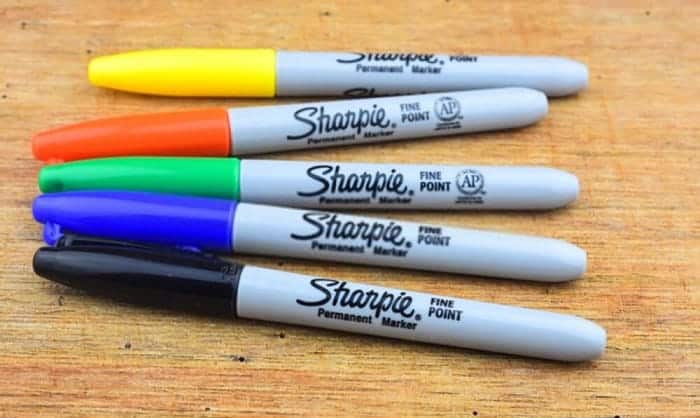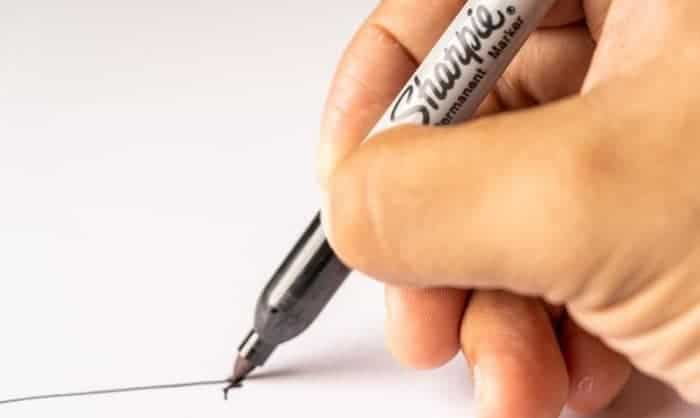
There are numerous ways we can use Sharpies as well as several extraordinary things people do with them. These mini tools are very versatile and can be used from signing documents, making autographs to creating various works of art. Some even use them to draw their eyebrows, create special makeup effects, nail art, and even skin tattoos.
Crazy it may seem, but others use Sharpies to make face pranks. Well, with its many uses and versatility, you may want to know or at least verify for sure if it is safe.
Some may ask, “Are Sharpies toxic on skin?”. And for most of us, the smell of Sharpie-marked documents is refreshing. But are we sure that these vapors are even safe if inhaled or are these chemicals safe on the skin? Let us consider some of the facts right here.
Table of Contents
Are Sharpies Toxic?
As discussed, there are Sharpie markers without xylene, and some industrial types have these solvents, which are harmful to your skin. There are also Sharpie types with a seal from Arts and Creative Materials Institute or ACMI, which indicates that the product is non-toxic and safe for art, and drawings even for children. However, this does not include safety for body art or skin drawings.
The ACMI seal is given after undergoing toxicological testing and deemed safe if inhaled or ingested. It is not recommended to use these markers on the skin. But if used moderately and under adult supervision, the ink components will generally pose no harm other than minor skin irritation or rashes to some delicate or sensitive skin of children.
What is Xylene

Xylene is a petrochemical used as a solvent that dissolves other substances like in the printing industry. It is also used as a cleaning, paint thinner, and a major component in varnishes.
Since it is also a kind of benzene chemical, it is flammable and hazardous in a large amount. It may cause skin irritation and may remove natural oils from the skin to make it unusually dry. Xylene serves as a solvent in most permanent markers.
Which Types of Sharpies are Safe on the Skin
Average Sharpie markers do not contain xylene and are, therefore non-toxic and safe. Permanent markers that do not use xylene as their solvent or one of their ingredients are safe to use on your skin.
You may wish to check the label if your marker or Sharpie does not contain any other types of benzenes similar to xylene. Xylene-free Sharpies are not that strong if you smell their tips compared to some with xylene or other benzenes.
Tattoo artists are very much dependent on Sharpies to display their art before using their needles. Most of them use xylene-free Sharpies while others use sterile skin markers from Electrum, Squidster, DERMarker.
When we say non-toxic and safe, we mean that it is not harmful to your skin as long as it is temporary and no open wound is present. Xylene-free sharpies are only marked or drawn on the skin surface and the solvent used immediately dries up.
But of course, using these Sharpie inks unintentionally with an open wound is a different story. Any foreign body entering the skin wound is harmful.
Different Types of Sharpies
Generally speaking, Sharpie fine point markers are xylene-free and, therefore non-toxic and safe to use on your skin moderately. But other types of Sharpie contain xylene and these markers are not intended to be used to draw on skin. Their fumes are also to be avoided.
These types are King Size Permanent Marker Sharpies, Sharpie Magnum Permanent Marker, and Furniture Touch-up Sharpie markers. Their xylene content is industry-grade and designed for heavy industrial or business use. These types are not intended for human skin.
The average type of Sharpie is generally safe depending on the coverage of the skin where it was used. Anything used in excess to moderation or afar from its actual use may pose some disadvantages.
Some tattoo artists use different colors and variants of Sharpies to sketch their designs before implementing the tattoo arts on your skin with a needle; they make sure that these are the non-toxic types.
Is Sharpie Ink a Safer Alternative for Tattoo Ink

After using the Sharpie marker onto the skin and the ink has dried, the solvents in the ink eventually evaporate. At this stage, there is a lesser risk coming from the product. Sharpie ink remains on the skin surface, leaving the pigments on the top layer of the skin.
The ink’s pigment will fade off within a few days or immediately when cleaning solutions or mineral oil are used to loosen the pigment structure. Afterward, the remaining ink will be washed off with soap and water. Adverse reactions from ink pigments are very uncommon.
On the other hand, tattoo ink may expose you to ink poisoning since itse pigment and liquid solution may go deeper into your skin and bloodstream. This is the reason why most tattoo enthusiasts prefer temporary tattoos made from Sharpie non-toxic pens.
However, this comparison is limited only to which is safer but not if what is the safest. The truth is that Sharpie pens are not designed to be used on the skin. Nevertheless, if used moderately, then no need to worry if it is fatal or not especially if it is xylene-free.
Some Reminders When Using Sharpies on Your Skin
- Drawing on your skin with a Sharpie is generally safe but there is an additional safety measure you must take in using cleaning products to remove them. You may need an alcohol-based cleaning solution to clean your skin and it may cause mild irritation or rashes if used more frequently.
- Be more careful when removing Sharpie drawings or markings on your face especially near your eyes. Alcohol-based cleaners may cause mild to severe irritation.
- Sharpies on the skin cannot cause skin cancer or other major problems since it does not penetrate so deep to modify skin cells. But prolonged use and bigger coverage may block the skin’s ability to breathe and may cause irritation and rashes.
- Use gentler cleaning solutions for quick results such as hand sanitizers, mild rubbing alcohol (40% ethyl solution), or nail polish remover.
- Whenever children use a Sharpie on their skin, strict adult supervision must be considered to ensure that these skin parts are safe to clean afterward.
Conclusion
Sharpies are indeed very versatile with their uses. Average Sharpies with no xylene or benzene contents are safe if used on skin and non-toxic after all.
However, be aware that the industrial-grade or types of Sharpies may contain xylene or benzenes that are harmful if used on the skin for a long period, especially on large skin areas. It is therefore very important to inspect the labels, contents, and use of every Sharpie marker you intend to purchase or even use.
Another important consideration and care that should be focused on are cleaning the marked, drawn areas with gentler or mild cleaning solutions. Extra care must be considered when cleaning areas near your eyes, mouth, and nose. Xylene-free Sharpies may not be toxic but your cleaning solutions may cause skin irritation and rashes if used long-term and in high concentration.
Hope you like this “Are Sharpies Toxic on Skin” article. And if you have any questions or concerns, don’t hesitate to share them in the comment box below. I’m glad to hear it from you. And if you found this article helpful, please share it with your friends and family! Thank you very much!

I am a former art teacher, so it is evident to me the importance of art in educating the new generation. We also want to help parents who plan to teach their children and desire the best tools and tips for them.